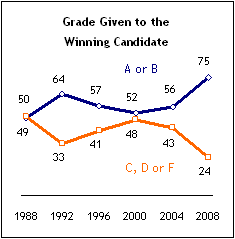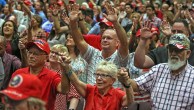Remarks by Andrew Kohut, President, Pew Research Center
2nd Annual Warren J. Mitofsky Award Dinner, on Behalf of the Roper Center
Newseum, Washington DC
Here’s my quick review of what happened on Election Day and why.
First, the middle asserted itself. This was not a base election. Independents broke decisively for Obama, favoring him by a 52%-to-44% margin over John McCain. Obama also won an overwhelming 60% of self-identified moderates. By comparison, John Kerry carried 49% of independents and 54% of moderates four years ago.

Second, the political landscape shifted, mirroring pre-election polls that have shown increased Democratic party-affiliation since early 2006. While in 2004 the electorate was equally split along partisan lines, this year it was dramatically more Democratic (39% Democratic vs. 32% Republican).
Call it the Bush effect. The Republican brand has been severely damaged by the presidency of George W. Bush. The financial crisis and falling stock market cannot explain away the GOP’s troubles here. Iraq, Hurricane Katrina and a long list of criticisms of the Bush administration created a significantly more advantageous party-identification spread for the Democrats than Bill Clinton had in either of his two victories.
The third important element of this election was the age gap — the divergence between the candidate preferences of the youngest and oldest voters was the widest in decades, perhaps ever.
More young voters, those ages 18-29, have now moved into the Democratic column in three consecutive national elections — 2004, 2006 and 2008 — than in the three previous comparable elections. But the strength of this now strong-Democratic constituency was further enhanced by the presence on the ticket of a candidate who was so appealing to younger voters. From the very start Barack Obama swept them off their feet. Obama won voters under the age of 30 by a dramatic two-to-one margin (66% to 31%). By comparison, Kerry won 54% of voters under 30, while Al Gore was not able to carry even a majority of the young vote (48%) just eight years ago.
But, one surprise here was that, despite predictions to the contrary, turnout among young voters was not disproportionately higher than in 2004.
A recent analysis by Pew Research Center’s Scott Keeter shows that young voters are more racially tolerant, much more supportive of an activist government (69% favor an expanded role for government vs. 51% overall), more anti-war (77% disapprove of the U.S. war in Iraq vs. 63% overall) and as many as a third call themselves something that had become a dirty word to their parents — liberal.1

At the other end, one of the few groups not to back Obama more than Kerry four years ago were seniors, who favored McCain by 53% to 45%. In his reelection in 2004, Bush carried seniors by a tighter 52%-to-47% margin.
Among other things, this brings us to the issue of race, which is still a complicated story. Obama owes much of his electoral success to stronger support from African Americans and Latinos. Compared with Kerry, Obama’s vote was 7 percentage points higher among blacks and 13 points higher among Hispanics.
White voters backed McCain by 55% to 43%. Still, Obama did better among them than Kerry by a modest three percentage points. However, when you unpack the white vote, you find that Obama made large gains among young whites, well-educated whites and affluent whites.
Overall, the groups we found to be least racially tolerant — the white working class, white Southerners — did not join the Democratic tsunami. But these groups did not buck it either, giving Democrats roughly the same share of the vote they did four years ago.
However, when we unpack the data further, we do find that the very least tolerant groups — older white working class voters and older white Southerners — gave McCain somewhat more support than they gave Bush 4 years ago.
In sum, race was certainly a factor in the vote, but on balance more of a positive than a negative for Obama. Black turnout (13% of the electorate) was considerably higher than it was in 2004 (11%). That 20% increase in black turnout is attributable to first-time voters. Overall, 19% of African American voters were first time voters compared with 8% of white voters who went to the polls for the first time. The increased turnout combined with the near universal support for Obama among black voters alone was responsible for adding a couple of percentage points to his overall popular vote take.
By contrast, the 7% of whites who said race was a consideration in their vote and who broke heavily for McCain by 63% to 36%, was a smaller negative factor.
Clearly, the economy was the dominant issue of the fall campaign, much more so than any other issue in any election in a long time. It certainly took national security off the minds of voters.
But let’s not understate the importance of Obama’s achievements in instilling confidence in his leadership abilities, or of McCain’s shortcomings in doing likewise. McCain’s large advantage in early September on the question of leadership was not only erased, but reversed by Election Day. Nearly six-in-ten voters leaving the polls felt Obama has the right judgment to make a good president. Only 49% said the same of McCain.
And there is good evidence the campaign — and especially the presidential debates — mattered this year. Obama’s leadership image improved following the first debate and was reinforced by the following two while McCain’s leadership image was weakened. Sarah Palin mattered too. In fact, she is the only vice presidential candidate in my recollection whose image has had a measurable effect on voting preference. Joe Biden had no such effect on the electorate.
A lot of speculation has begun over whether this election signals a re-alignment — a move to the left. There is no sign of that in what we see.

With regard to ideological self description there was no movement. Roughly the same percentage of voters call themselves liberal (23%) today as did in 2004 (21%). A plurality of voters still call themselves moderate (44% now vs. 45% in 2004) and roughly a third identify as conservative (33% now vs. 34% in 2004).
Beyond labels, we saw a mixed ideological message in what voters were saying. A majority of Americans (51%) want the government to do more to solve problems, up from 46% in 2004. But on the other hand, Americans sided with conservatives in support of offshore drilling (68% favor) and voter-approved gay marriage bans were passed in three states (California, Florida and Arizona).
Looking beyond exit polls to other recent studies of the political landscape, we do see more public support for an activist government. However, this level of support has only brought the public back to where it was pre-Gingrich Revolution — from the mid ’90s back to the late ’80s.
Whether the public will follow Obama and the Democrats further to the left — if that’s the way they go — will depend on performance, performance, performance. Recall that Ronald Reagan succeeded in moving the country towards conservatism not with his election, but post-Morning in America.
With two wars, a deepening economic crisis, environmental concerns and other challenges already bearing down on Obama’s presidency, this will not be an easy task. The public’s patience will be tested, and he will be judged most crucially by the least ideological and most pragmatic elements of the electorate — independents and moderates. Will they be disgruntled or satisfied by his performance? That will tell us which way the wind will blow.
Looking to post-election polls, while Barack Obama may have claimed only 53% of the vote on Election Day, he has received a landslide greeting from the American public. In a Gallup survey, Obama’s favorables stand at 68%, higher than Bush in 2000 (56%) or Clinton in 1992 (60%).

Pew found voters gave Obama high marks for how he ran his campaign. Fully 75% of voters gave his campaign an A or B grade, the highest percentage any candidate has received since Pew began asking voters to grade presidential campaigns in 1988. In fact, on average, a winning candidate has received an A or B grade from about 55% of voters the past five presidential cycles.2
Despite the deep hole the country finds itself in, characteristically, the public is highly optimistic that Obama will succeed. Pew found 67% of voters believe Obama will be successful in his first term, and 65% in a Gallup survey said the country will be better off four years from now. Only 50% saw improvement for the country ahead after Clinton’s election in 1992 and Bush’s in 2000.

A good deal of these high expectations reflects the current deep public concern about the state of the nation — conditions are bound to get better at some point. But some of it has to with Obama, who has emerged from a tough and often negative campaign with his image intact, if not enhanced.
I think this is because of his very special ability to communicate and connect, even with those who may not have voted for him. Surprisingly, Obama elicits far more positive reactions from voters now than he did prior to the general election campaign. Pew’s survey finds more voters say Obama makes then feel proud now (65%) than did so in March (42%). More voters also say he makes them feel hopeful, while far less feel angry about him. These positive responses have increased across partisan lines over the past few months. Unquestionably, this is good news for the new administration.
Obama may receive a sweeter and longer honeymoon than most new presidents, but he will surely need it given the problems he faces. How long voters stay hopeful about Obama will be the important question of 2009.
Notes
1 Young Voters in the 2008 Election, Pew Research Center for the People and the Press, Nov. 12, 2008.
2 High Marks for Campaign, High Bar for Obama, Pew Research Center for the People and the Press, Nov. 13, 2008.
